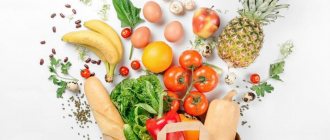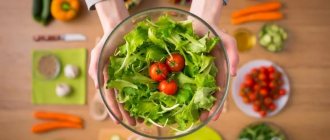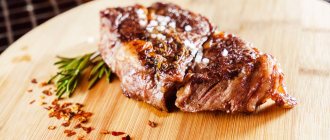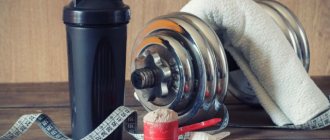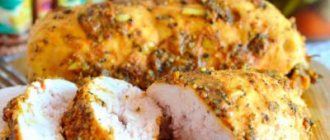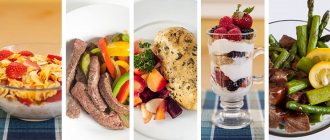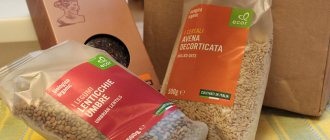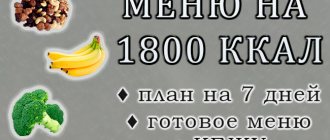People who are prone to being overweight and trying to regain their shape with the help of a variety of diets are well aware that refusing a low-calorie diet inevitably leads to a rapid gain of excess body weight. That is, to maintain slimness you will need to adhere to dietary restrictions throughout your life? Not at all.
Modern nutritionists offer effective ways to lose weight that do not limit your diet to a minimum, allow you to keep your weight within the normal range and not feel a constant feeling of hunger. Such amazing techniques include separate nutrition, the essence of which is the separation of protein and carbohydrate foods.
By adhering to the basic rules of the diet, you can not only get rid of excess weight, but also cleanse the body and prevent weight gain in the future.
Basic principles of separate nutrition
Separate nutrition for weight loss is a simplified version of a therapeutic and prophylactic diet developed by specialists to improve the health of the body, stimulate metabolic processes and normalize the activity of internal organs.
The main principle on which this diet is actually based is the refusal to combine protein and carbohydrate foods. In addition, following this diet requires compliance with a number of conditions:
- Products that have a sour taste cannot be combined with any others. They should be consumed 20-30 minutes before main meals.
- Proteins are compatible only with vegetables that do not contain starch.
- To lose weight, it is recommended to drink one glass of warm water 15 minutes before your main meal.
- It is recommended to include more fruits in the menu in the morning, vegetables containing starch in the afternoon, and in the evening preference should be given to protein foods.
- You cannot combine two or more protein or carbohydrate foods in one meal.
- You should only eat warm food.
- Milk should be consumed separately from any other foods and drinks.
The basis of a separate diet for weight loss is a complete rejection of harmful, that is, fatty, heavy, spicy, sweet foods. You should also not use preservatives, marinades, or pickles. Food should be as simple, fresh and natural as possible.
Negative effects of diet on humans
In the process of constantly being on a diet according to the principles of separate nutrition, a person develops not only a psychological habit, but also the inability to eat mixed food without any negative manifestations from the digestive system. So, after attending some event and eating the “wrong food”, you can feel discomfort and malaise . This is due to the fact that the body has also adjusted to a new regime of separate nutrition.
Also, the period of getting used to a new way of life is quite long and difficult. Often people feel hungry while hungry and get all the necessary nutrients from food. It should not become a diet, but a way of life.
Product Compatibility
The creator of separate meals, Herbert Shelton, outlined several important rules regarding the compatibility of products, which are recommended not only separately from each other, but also at different times, and even better - on different days.
- Proteins and carbohydrates . Thus, you should not consume dishes that are so familiar to the common man, such as potatoes or pasta with meat, porridge with bread and other flour products.
- Starch and acids . Vegetables and fruits that have a sour taste should not be combined with starchy foods.
- Squirrels . Despite the related composition, you cannot combine products containing animal proteins. So, for example, you should avoid eating eggs, meat, cheese, fish, and seafood at the same time.
- Proteins and fats . In a simplified version, this rule literally means the following: when cooking meat, fish, and seafood, you cannot use vegetable oil or butter.
- Starch and sugar . That is, you need to give up dishes that are so beloved by many, such as sweet cereals, pies, buns, and baked goods.
- Single products . This category includes the following: watermelons, melons, milk. It is permissible to eat them separately from other dishes and only as an independent meal.
An undeniable advantage of a separate diet is the ability to eat any amount of food. Of course, if your main goal is to lose weight, you should not overeat. It is better to eat more often, for example, every 2-2.5 hours, but in small portions.
Proper nutrition, also aimed at healing and cleansing the body, implies partial or complete rejection of salt, sugar, and spices. To improve the taste of dishes, it is allowed to add greens to them.
Proper nutrition: what goes with what
Modern nutritionists and naturopathic doctors have much in common in their understanding of healthy eating:
- You need to be able to combine products correctly, for example, cereals can be combined with vegetables, but flour products should not be consumed with sweets;
- The share of fresh vegetables and fruits in the diet should be more than 50%;
- You need to chew food slowly and be sure to listen to the feeling of fullness;
- You need to eat in moderation and maintain high physical activity;
- The last meal should be 4-6 hours before bedtime;
- You need to exclude any refined foods, fast food and table salt from your diet;
- You can’t go to stores on an empty stomach;
- It is advisable to stick to two meals a day.
Scheme of the optimal combination of food products according to G. Shelton
Rules for healthy eating according to Ayurveda
To get a complete understanding of the rules of nutrition and a healthy lifestyle, let us turn to the ancient texts of Yoga and the Vedas. Thus, Ayurveda says:
The nutritional rules of each person are individual and depend on his nature, innate constitution, metabolic rate, life goals and personal duty to society.
Ayurveda contains knowledge about how, with the help of certain nutritional rules, you can influence the state of a person’s body and mind. According to this text, the body's constitution is determined by the balance of three physical energies called Doshas: Vata ('Wind'), Pitta ('Bile') and Kapha ('Mucus'). It is believed that health is in order when all three Doshas are balanced with each other. For example, a person with a predominance of Kapha is a person with a slow metabolism and suffering from excess weight. To restore health, such a person needs to eat foods that reduce Kapha and increase Pitta and Vata.
Ayurveda also explains what nutrition is required for different activities and also relates a person's activities to the nature of his thoughts. A person's thoughts can be in one of three states: goodness (Sattva), passion (Rajas) and ignorance (Tamas). For example, a person who is in a state of Rajas is very active, impulsive and may take hasty actions. In the state of Sattva, a person is calm and reasonable. In a state of Tamas, he is indifferent and lazy.
Foods of goodness include: cereals, legumes, nuts, honey, cereals, fruits, dairy products.
Passion foods include: spicy foods, onions, garlic, tea, coffee, fried foods.
Foods of ignorance include: highly fatty or highly sweet foods, spoiled or old foods, refined foods, alcohol, white flour, meat products, fish and eggs.
Through a certain combination of food products, Ayurveda allows you to regulate both the mental state and the constitution of the human body. For example, for a person engaged in spiritual practices, it is necessary to eat sattvic food, and if such a person has an active metabolism, sattvic food must be combined with food that increases Pitta Dosha, i.e., slows down the metabolism. Another example: if a person who is active and active by nature experiences apathy or laziness at some point in his life, then he may need to eat rajasic foods in combination with foods that restore the balance of his Doshas.
Despite the individual approach to human health in Ayurveda, there are a number of general universal rules for healthy eating:
- Fruits are best eaten separately from other foods;
- Rice and other grains go well with vegetables;
- It is permissible to consume dairy products (buttermilk, yogurt, kefir) with cereals and vegetables;
- Honey should not be heated; when heated, it acquires toxic properties;
- Milk is not consumed together with vegetables, legumes, sour fruits and fermented milk products;
- Water should be drunk at least half an hour before meals;
- It is advisable to prepare food in a state of calm and peace of mind
Preparatory stage
To make the transition to a new lifestyle less painful, a few days before starting the diet, it is recommended to introduce new rules into the diet that will help prepare the body for some restrictions. First of all, a week before starting the diet, it is recommended to give up junk food and alcohol. It is also recommended to reduce the size of your usual servings.
Next, you need to increase the number of meals to 5-6 times a day. Regardless of whether you need to lose weight or not, it is important to drink clean, warm water 15-20 minutes before meals. This simple measure will help you get full faster. Immediately before, during meals and immediately after finishing the meal, drinking water or any other drinks is strictly prohibited.
Separate proteins from carbohydrates
The central principle of separate nutrition is to distinguish between the intake of carbohydrate and protein foods.
- Protein nutrition. Proteins are necessary for the normal functioning of the body; they are found mainly in fish, nuts, meat, and eggs. It is enough to consume protein foods 2-3 times a week, as they are completely digested.
- Carbohydrate nutrition. Involves eating only energy foods - sweets, cereals, grains, flour, potatoes. All of them are digested fairly quickly and form the basis of nutrition.
If you consume only compatible products, they form a mass that is homogeneous in chemical composition, which facilitates and speeds up the digestion process. Eating proteins together with carbohydrates significantly complicates the digestion process and leads to the deposition of undigested residues on the walls of the large intestine.
It is necessary to ensure that the difference between the intake of protein and carbohydrate foods is at least 2 hours.
Back to Contents
Product Compatibility Chart
The creator of the diet, which promotes separate nutrition, has developed a special table that displays options for combinations and incompatibility of foods.
Reviews from adherents of separate meals recommend printing the table in large, bright font on paper and placing it in a visible place in the kitchen. This little trick will be a great help when preparing different dishes.
How to work with her
The compatibility table for separate meals for weight loss seems complicated only at first glance. In fact, it is simple and convenient to use. To determine the compatibility of certain products, you must select a written name in the vertical column and a numerical name in the horizontal one. After that, draw a parallel between the selected options and evaluate the result.
The “plus” sign means ideal compatibility of the products; the “minus” sign means that they cannot be combined categorically. As for “zero”, these products can be combined, but doing this is often not recommended. An exclamation point indicates that the parallel was drawn incorrectly.
Insulin
Insulin is the most controversial (or, as Lyle McDonald says, schizophrenic) hormone. If you read the literature for bodybuilders interested in muscle growth, insulin is on the pedestal, because it is an anabolic hormone. If you read the “weight loss” literature, insulin is a real devil, which interferes with fat burning and generally makes you fatter. Who is right? Everyone is right, because insulin is an energy storage hormone. Whether he does good or bad things depends on the context.
Carbohydrates increase insulin. But food doesn't need to be carbohydrates for insulin levels to rise. Protein also increases it (,). And proteins and carbohydrates together increase it even more than each individually. And this is good: if insulin is not produced in the body, type 1 diabetes develops.
The role of insulin is to supply glucose to the body's cells, releasing it from the blood. Thus, insulin stimulates the accumulation of glycogen in the liver and muscles, protects muscle mass from breakdown, which is a big plus for those who grow muscles.
But insulin is also involved in fat storage, which is where it gets its bad reputation. But this is not the only and not the most important hormone responsible for fat accumulation. There is a hormone called ASP that does this well without insulin (,).
In addition to the fact that insulin replenishes fat reserves, it also sharply suppresses lipolysis (the release of fat from the fat cell for subsequent burning). So some could easily come to the conclusion (and do) that a carbohydrate diet makes fat loss impossible.
But in the body, every day (and more than once) the anabolic phase turns on, when nutrients begin to be absorbed after eating (nothing remains floating in the blood forever), then the catabolic phase, when reserves begin to be spent if the body has a general daily calorie deficit.
Ultimately, for weight loss, only the amount of energy received and spent per day plays a role. If you burn more calories than you eat, you will lose weight regardless of your insulin levels, the amount and timing of fat you eat, the planetary positions, or solar flares.
Products for the week
You can stick to separate meals throughout your life or for several days. The second option is especially suitable for women and men who need to quickly and effectively correct their figure at home, getting rid of a few extra pounds.
Below is an approximate menu of separate meals for weight loss for a week:
- Breakfast: oatmeal cooked in water, option – buckwheat porridge, omelet and cucumber salad.
- Second breakfast: any fruit with a sour taste.
- Lunch: vegetable soup, steamed beef, fish option, and tomato salad.
- Afternoon snack: cottage cheese.
- Dinner: stewed vegetables and fish, option – seafood.
It is permissible to drink only pure water as drinks. It is better to avoid tea, including green tea, during the diet.
If the main goal of the diet is to lose weight, you should categorically avoid snacking between main meals. When you feel a strong feeling of hunger, it is recommended to eat any sour fruit.
Why is it important to combine foods wisely when losing weight?
In order not to experience hunger and constant irritability from food restrictions, you need to organize a moderate and balanced food intake. A table of food combinations for proper nutrition and certain recommendations help you cope with this task.
This is useful: PP menu for 7 days.
Constantly feeling hungry when eating regularly or gaining weight when eating on a limited basis are the first indicators that your menu does not match the combination of foods with proper nutrition.
Menu for separate meals for a week
Based on the original version of therapeutic separate nutrition, many other diets have been compiled, the most popular among which is the so-called “90 days” diet. This method allows you to quickly lose weight, improve the condition of the skin, remove toxins from the body and increase its tone.
The basic principle of the diet is to alternate four days, during each of which you can eat only certain foods, for example, those containing large amounts of proteins, carbohydrates or starches. These four food options must be alternated consistently throughout the diet.
To obtain maximum results, it is recommended to add to the diet any physical activity, water procedures, massage, visiting a bathhouse or sauna.
Monday
Protein or protein day . On Monday, it is recommended to eat yogurt or a steamed omelette of 2-3 eggs for breakfast. For lunch, warm beef broth with a small piece of whole grain bread is perfect. For dinner, you can treat yourself to a salad of cucumbers and herbs, as well as boiled beef or a piece of steamed fish. For an afternoon snack, it is better to eat a green salad, and for a second breakfast you can choose natural hard cheese.
Tuesday
Starchy . The favorites of this day are cereals and legumes. You can eat porridge cooked in water, without adding salt, sugar, or fruit. For lunch, it is recommended to choose vegetable soup cooked in vegetable broth. You can add a few whole grain bread croutons to the finished dish. For dinner, second breakfast and afternoon snack, you can eat any vegetables, boiled or baked.
Wednesday
Carbohydrate . This day is especially appreciated by lovers of delicious food, because at this time you can treat yourself to vegetable pizza, pasta with vegetables, warm vegetable salad without dressing, as well as any pastries that do not contain products such as sugar and eggs. For breakfast, lunch and afternoon snack, you can choose any dish from the list suggested above, but for dinner you just need to eat a small amount of natural dark chocolate.
Thursday
Vitamin . This day is a kind of fasting day, and also helps to saturate the body with much-needed vitamins. Throughout the day, you can eat any fruits and vegetables, fresh, baked or boiled. You can diversify your diet by adding some dried fruits, seeds and nuts.
Friday
Starting on Friday, the diet is repeated. That is, this day is a protein day . Throughout the day you can eat any type of meat, fish, seafood. You can also eat yogurt and eggs. For variety, you need to add fresh herbs or any vegetables that do not include starch.
Saturday
Starchy . For breakfast, it is recommended to eat oatmeal cooked in water. During the second breakfast, it is better to choose a salad from any vegetables; it should not be dressed. Vegetable soup is perfect for lunch. But for dinner and afternoon snack, you can prepare a casserole from any vegetables.
Resurrection
Sunday is also a carbohydrate day, during which you can eat foods that are extremely difficult to call dietary, that is, pastries, pizza, chocolate. But we should not forget that portion sizes must be limited.
The concept of RP and its principles
This is not just a diet, but a full-fledged scientific research, reflected in the works of scientists from different parts of the globe.
Understanding product combinations will be difficult only at the very beginning. Over time, you will begin to navigate tables fluently
Its roots go far back in history: back in the days of the Roman Empire, the healer Aulus Cornelius Celsus spoke about the dangers of simultaneous consumption of fatty, sweet and salty foods, as well as flour products.
In the 19th-20th centuries, these ideas were revived in the work of Academician Pavlov, who is known to us through his studies of conditioned reflexes and dubious experiments with dogs.
Ivan Petrovich, through a series of experiments, proved that the human body assimilates foods in different ways.
Thus, for the digestion of proteins and carbohydrates, completely different amounts of gastric juice are released, which also has a new composition each time.
And at each stage, the digestive system secretes different substances to process certain elements.
Tip: you yourself can track the difference in how your body perceives food, noticeable already in the first stages of digestion. Just pay attention to the fact that when you see different foods, your mouth produces different amounts of saliva.
The next completely logical question that the academician asked was: what happens when different enzymes are mixed with each other?
Eating healthy is easy!
This leads to poor processing of some parts of the food, which remain in the digestive system, where the processes of fermentation and decomposition begin.
They, in turn, can cause the accumulation of toxins in the body and the appearance of excess weight, which is then quite difficult to get rid of.
Pavlov stopped there, but an American scientist named Shelton went further in his research.
His book on this topic served to popularize RP by providing people with a simple and understandable diagram of product compatibility.
According to Shelton's principles, products are divided into several groups:
- Carbohydrates: cereals, baked goods, sweets and fruits, potatoes, etc.
- Protein: soy, nuts, etc.
- Sour fruits: green apples, citrus fruits, pineapples, etc.
- Sweet fruits: red apples, peaches, apricots, etc.
- Green vegetables: zucchini, cucumbers, cabbage, etc.
The scientist identified melons and watermelons as a separate category as fruits containing a large amount of liquid.
This system allows you not only to get rid of extra pounds, but also to say goodbye to many chronic diseases
Basic principles of separate nutrition
Consumption of only those categories of products that “find a common language” with each other - this is the essence of RP.
Eating right is a simple science, but the key to understanding it lies in remembering nine basic rules:
- Separate foods from the acid and starch (carbohydrate) lists. Acids neutralize the alkaline environment needed to digest starch, which can result in indigestion.
- Separate proteins and carbohydrates into separate meals. Protein foods require an acidic environment to digest.
- Eat only one type of protein food at a time.
- Protein and acidic foods should be in different meals. Acids inhibit the secretion of gastric juice, and for successful digestion of protein foods there must be a lot of it. Failure to comply with this rule often causes food poisoning.
- Fats and proteins should also not be in the same lunch. This is because fatty foods take much longer to process.
- Fruits and all sweets do not go well with protein foods. Distribute them among separate meals.
- Fruits also do not go well with flour products. Bread and similar products delay the digestion of fruits and create heaviness in the stomach.
- Melons and watermelons do not go well with anything, including each other.
- Forget about desserts. The charge of carbohydrate sweetness following the main course is dead weight on the entire dinner, which is processed only into fermentation products, vinegar and alcohols.
The main thing: the right combination of products
Quitting the diet
Recipes for separate meals for weight loss are varied and tasty. However, most people still do not strive to adhere to this diet throughout their lives. After achieving the desired result, you can gradually return to your usual diet. To avoid rapid weight gain, you need to follow a number of rules for exiting the diet.
New products should be introduced into a gentle menu in quantities not exceeding 1-2 per day. You should switch to a mixed diet no earlier than a week after completing the diet. In order for the results to last for a long time, it is recommended to adhere to some healthy eating rules. For example, you can stop eating fatty foods, sweets, and baked goods.
An incorrect exit from the diet can lead not only to a rapid gain of excess body weight, but also to a number of health problems, including dysbiosis and disruption of the digestive tract.
Recipes
All recipes for separate meals are easy to prepare and will not take much time.
Lenten vegetable soup
Recipe No. 1
Cooking method:
- Peel the vegetables, rinse, cut into cubes. Boil all ingredients until tender.
*Can be served with rye breadcrumbs.
Ingredients: - Potatoes - 210 g; — Carrots – 60 g; — Onion – 40 g; — Fresh green peas – 50 g; — Parsley – 10 g; — Water – 1 l.
Steamed veal with carrots in a slow cooker
Recipe No. 2
Cooking method:
- Wash the veal and cut into slices.
- Wash the carrots, remove skins and stems.
- Place the ingredients in the multicooker bowl; cooking time in the “Steam” mode is 20 minutes.
- Chop the parsley and decorate the finished dish.
Ingredients: - Veal - 500 g; — Carrots – 150 g; — Parsley – 15 g.
Baked pumpkin with prunes
Recipe No. 3
Cooking method:
- Pour boiling water over pitted prunes and leave for an hour.
- Wash the pumpkin, peel it, cut into slices or cubes.
- Grease a baking sheet with a drop of vegetable oil and lay out the ingredients.
- Place in an oven preheated to 180 degrees for 20 minutes.
*On a carbohydrate day, you can serve it with honey.
Ingredients: - Pumpkin - 500 g; — Prunes – 100 g.
Nutritionist opinion
The opinions of nutritionists regarding separate nutrition are ambiguous. Most practitioners note that such a diet has a positive effect on the functioning of the body, normalizes the activity of the intestinal tract, and triggers metabolic processes.
However, there are also opponents of the diet who believe that giving up regular food can disrupt the body’s functioning and lead to accelerated weight gain.
The positive aspects of this way of life
Thanks to this diet, digestion is improved, and fermentation processes and putrefaction in the intestines do not start. You can get rid of excess weight and improve the condition of your entire body. With regular use, the results last for a long time. In case of disorders and deterioration in the functioning of the gastrointestinal tract, separate nutrition becomes very useful.
Based on the results of past years, the food compatibility table has been finalized and today has the most complete list of possible components.
Nutrition for physically active people
Proper nutrition, which ensures the compatibility of foods, is very important for the health of athletes. The table helps you create a diet that is optimal for sports activities.
The diet is similar to the rules for weight gain, but there are several additional recommendations:
- consumption of clean water should be at least 8 glasses per day - liquid speeds up metabolism;
- before training (2 hours before) you need to take a protein meal;
- meals should be fractional (eat 4-7 times a day);
- adding more complex carbohydrates (cereals and legumes) to your diet is a source of energy.
Sample menu for athletes:
- breakfast: sandwich with butter / oatmeal / omelette of 3-4 proteins;
- second breakfast: stewed cabbage/vegetable salad/fruit salad with nuts;
- lunch: fish or meat with vegetables/stew/rice porridge;
- afternoon snack: cottage cheese/boiled buckwheat/soup;
- dinner: fish or meat/stewed vegetables/salad;
- before bed: 250 ml of kefir.
Below are recipes for high-energy meals for athletes.
Granola
To prepare you need to take:
- oatmeal – 1 cup;
- almonds – 100 g;
- various dried fruits to taste – 10 pcs.;
- yogurt or kefir.
Cooking process:
- Chop dried fruits and mix with cereal and nuts.
- Place in an oven preheated to 180 C for 5 minutes.
- Can be consumed dry after cooling or poured over yogurt.
Shrimp salad with avocado
Ingredients:
- king prawns – 8 pcs.;
- arugula – 150 g;
- avocado – 1 pc.;
- olive oil 2 tbsp. l.;
- lime – 1 pc.;
- salt pepper.
Cooking process:
- Peel and boil the shrimp.
- Peel the avocado and cut it.
- Rinse the arugula, dry and tear.
- Mix all ingredients.
- Season with lime juice and oil, add spices.
How long should you cook shrimp?
Sheldon’s table is an assistant to everyone who wants to switch to proper separate nutrition. By following the advice of a nutritionist about the compatibility of foods, you can quickly improve your body’s condition, lose or gain weight.
Author: Bellatrix_L
